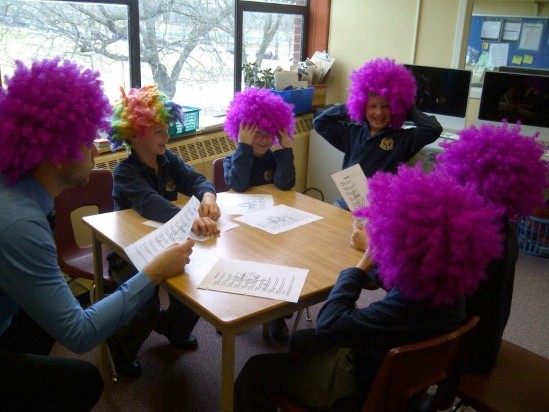Teaching through inquiry seems to be the “new black,” but what does “inquiry” actually mean? Curriculum documents and research provide models of inquiry cycles to use as a guide, but what do inquiry-based classrooms really look like?
We view inquiry as much more than a research process. We believe inquiry is a philosophy of teaching and learning whereby teachers and students work together to grapple with authentic problems.
An inquiry-based classroom is a collaborative classroom. When we work together and our thinking is challenged by others, we come up with better ideas and develop deeper understandings. When students of differing strengths are grouped together, they learn new things about one another, and their skill sets often complement one another. The role of the teacher is fluid, shifting often throughout the inquiry process.
In the following example, students in an inquiry-based primary classroom explored how people use humour as a form of expression.
1. Observe and upload an issue
The classroom teacher and the teacher-librarian selected joke books, humorous poetry, and picture books with different forms of humour. Students chose any text they wanted to read during DEAR time or after they had finished assigned work. The classroom teacher designed a survey so the students could interview other adults in the school about what they found funny. Students also viewed videos and cartoons that showcased examples of humour from different parts of the world. The teacher’s role in this phase of the inquiry was to collaborate with the teacher-librarian to locate resources and to develop provocations for the unit.
2. Tease out the facets of the issue
Guided-reading lessons focused on comprehension strategies, but the texts were selected to delve into the function of humour in people’s lives. During small-group sessions, students also discussed poems written by Shel Silverstein and Jack Prelutsky.
In their role as guide, the teacher ensured that students were working in their zone of proximal development and provided explicit skill instruction when necessary. After each guided-reading lesson, students were invited to share some of their new insights during debrief time. The teacher modelled how to ask open-ended questions and pushed student thinking on a topic. The teacher shifted into co-learner mode – learning alongside students, modelling the learning process, and asking students questions.
3. Imagine how you might use what you have learned to contribute and make a difference
The guided-reading session on Patch Adams sparked the idea to raise funds to support a clowning program run through a local hospital. Someone suggested hosting a Funny and Yummy Bake Sale to sell treats and student-created books as a fundraiser for the hospital. At this juncture in the inquiry, the students collaborated with one another to generate a host of logistical and informational questions: How could they find a clowning program? How could they make a donation to a hospital? Could they hold a bake sale?Could they create humour books and sell them at the bake sale?
4. Design a plan
The bake-sale logistics were worked out, and students created humour books. In this phase of the inquiry, the teacher, back in a combined role as guide and co-learner, helped students develop skills and work together in small groups to find solutions to their questions.
5. Implement your plan with a real audience
Students hosted a Funny and Yummy Bake Sale. It was such a thrill for the students to share their information – how people use humour as a form of expression – with a real audience. Even those students who never seemed to care about the presentation of their work realized the importance of clarity and legibility in front of an audience. At the end of the project, the students and teacher held another debrief discussion to get feedback on the event, reflect on key learning, and pose new questions to drive future inquiries. Stay tuned!
Lara Jensen and Tina Jagdeo explore some of their collaborations with teachers and students in their upcoming book, BoldSchool. They would love to hear your stories of how inquiry works in your classroom.
